
“What should be included in board papers? How much detail should they go into? What makes a good set of board papers and why?” These are questions that are often asked. Whilst there is no ‘one size fits all’, the following advice from Stephen Cahill, our Regional Manager for Scotland, may help answer these questions and provide some useful guidance.
Board papers – do you really need them and if so, why?
The short answer to this is ‘yes you do’ – at least you do if you are serious about honouring your commitment to good governance in your charity. A board exists to discharge its governance role in a charity and, to do this it needs a flow of information. To set a scene it helps to think what functions board papers perform. Make these your yardsticks against which you can assess the usefulness of anything you include (or decide to exclude) from board papers.
1 – The record keeping and governance function –This is the ‘what you will do and what you did’, in terms of governing the charity and acting in the best interests of the beneficiaries. So, the record keeping part (minutes being the most obvious example) shows the chronology or historical record, of decision making. In plain English, what was decided and when. The governance part of this function is the ‘reasoning’ around why a decision was made – so, the narrative account of how a decision was arrived at. Really good minute taking is a fairly skilled job and sometimes between the time that rough notes were written and final minutes written up, things get missed out so, reviewing minutes as part of a board meeting is a good check to ensure accuracy. The basic maxim of ‘what was decided and what was the reasoning behind it’ is a good one and the acid test of good minutes would be where a stranger could read the minutes and makes general sense of them.
2 – The ‘bedrock of decision making’ function – This function is the harder – and more messy- function of board papers. A quality decision depends on quality information. Supporting information in board papers needs to feed the decision-making process. Too much detail or irrelevant detail and it becomes a ‘fog’ over decision making. Too little and it feeds the risk of making weak or sometimes wrong decision.
Good board papers contain a mix of standing items (so, matters that appear at each board meeting and are there as indicators or governance safeguards – e.g. finance report, risk register) and ad-hoc items – so for example, a report from a working group, or a particular topic of strategic interest to the board that they need awareness of, or, will base a decision upon.
Where things go wrong – a very brief analysis
Before suggesting what a pack of board papers could or should contain, a slight detour into where things can go wrong will help illustrate some key mistakes to avoid.
1 – The level of detail or ‘altitude’ – Board papers should be pitched at a level of detail that supports the ‘altitude' that a board should be working at. In terms of altitude, a board should be focused on the strategic direction of the charity – for example how well it is tracking its strategy and any threats that may serve to derail it. Using the analogy of a ship, the board should be sitting on the bridge and not the engine room. A common fault of board papers is to overload them with low-level operational detail. There may well be some nuggets of information in that detail but, they tend to get buried in the ‘noise’ of the sheer volume of detail. Boards differ in their levels of ability and a board that is slightly less developed can struggle seriously with overly detailed papers.
A pernicious result of overly-detailed board papers are the hours of work that end up going into producing reports etc that are never read nor, accomplish anything useful from a governance perspective. For example, overly detailed reports may well have some useful information in them but, may result in a board focusing on minutiae at the expense of more strategic issues. This is particularly common in less developed boards as it is often more comfortable for board members to focus attention on the things they are familiar with rather than the unfamiliar. Detail to a board needs to be pitched at the correct altitude. It is always easier for a board to ask for more detail than it is to have them to sift out extraneous detail.
2 – Timing and pre-reading – Board members need time to read, digest and reflect upon papers. Given that many charity board members have day jobs, a sufficient amount of time needs to be allowed for them to thoroughly understand what is presented to them and what is required of them (for example to decide something or simply for their assurance). Depending on when your board meets will help calibrate an appropriate timing for getting papers to board members but at least two weeks prior to the board meeting would be a reasonable start point.
What should be in a pack of board papers?
Starting from the absolute basics, these are the standing items that should be in every set of board papers.
An agenda. As obvious as it sounds, a well-structured agenda is essential. It provides record keeping, focus for discussion, and where time is likely to be limited in the meeting, a well thought out agenda will try to make time to ensure that important issues get the attention they deserve. It also helps to highlight any areas where there may be a conflict of interest and where trustees will be excused from participating in board business.
Pre-reading. Material needs to be sent to the board in advance for pre-reading. They need the opportunity to digest and reflect on it properly. It avoids the scenario of papers being read at the last moment and hastily made decisions based on incomplete understanding.
Minutes. These are the record keeping part of the board’s governance and should always be attached and agreed as a correct record by the board.
Finance report. For most charities, money is their lifeblood and substantial focus needs to be given to this.
Risk report. Risk in all its forms is also something that a board should give substantial attention to. Whether it is contained in a risk register or special report or a combination of both.
Invitation to exclude from participating in the agenda’s business/any declaration of interest or potential conflict of interest for any items of board business. It is important that you have this item on your agenda for transparency and good governance.
Significant developments. This part of the business captures any observation or events that are likely to affect the strategy of the board – for example, any new legislation or potential changes to arrangements. It is a good place to enable board members to use their intelligence gathering skills and bring it to wider attention. These need only be headlines and this alerts board members as to where they may need to step out or have declared an interest
Date of next meeting. This should always be on your agenda and it is often easier to get diaries together when board members are at the meeting.
The following are the optional or ad-hoc items you may want to include (it largely depends on your size and complexity as a charity. Smaller charities may not need all of these)
Headline operational report. Ideally this should be ‘by exception’. So, if everything is going well, the board merely need assurance that this is so. Any risk or significant development (positive or negative) should be reported in the standing items of the board’s business. Avoid overly detailed operational reports as it is too easy for a board to be drawn into the charity’s engine room, rather than keeping an eye out from the bridge.
Any sub group reports. This may include audit, remuneration, or whatever working groups you may have
By sticking close to all of the above you will at least have a bedrock of what constitutes a good set of board papers. You will save staff time and keep the board focused on the areas they should be focusing on. Above all else, use the two yardsticks given at the beginning when determining what should be included or excluded from board papers– namely ‘does the inclusion of information assist the record keeping or governance function’ and, ‘does the inclusion of information assist the decision-making function’?








